What showed tests of new flash-storage EMC XtremIO

This is how the transport box looked like, which came to us. The piece of iron is priced at like 3-4 apartments in Moscow.
In early March, we conducted an open test drive of a new flash storage system from EMC - EMC XtremIO. The system is considered one of the fastest storage systems in the world. Feature - inline-deduplication on board. Iron is expensive, but as one of our customers said: “Never mind, I will save $ 3 million a year on licenses only.” Because the array allows you to reduce from 128 cores to 64, and licenses are often counted precisely by cores. And yet, the system is especially interesting for those who work with virtual environments, who are looking for a way to reduce the response time of storage systems and who have performance problems.
The following tests were included in the menu: IOPS 100% read, random 4k; IOPS 50% read 50% write, random 4k; IOPS 100% write, random 4k. Conducted using IOmeter. We also tried the system in combat mode, watched its reaction to component failures (pulled the disk “live” under high load, rebooted the controller, turned off the power through one of the inputs, turned off the UPS) and peak load.
In general, there was something to see. Details below.
')
Flash vs hdd
XtremIO takes up 10 times less space in the data center than solutions on regular drives, which saves space in the server and power. It is generally appropriate to compare flash with similar solutions on disks. An ordinary cabinet with disks will give about 50 thousand IOPS, if we assume that an average of 250 disks fit into the cabinet, and each will generate 200 IOPS (although this is with a large margin). And these IOPS will be with a delay level of 3-9 milliseconds. The XtremIO cabinet will generate up to 1 million IOPS if required, and most importantly, delays will be less than 1 ms, which is very important for targeted applications.
Tests
Tests for reading were conducted on disks with created partitions and file system, in tests for writing they tried to test on raw devices without partitions, there the result is close to the line, apparently, the FS driver introduces such unevenness of the result. Tested on the last Iometer with the template Full random 4K Read, Full random 4K Write, Full random 4K Write 50%. The vendor stated, respectively, 250k IOPS, 100-150k IOPS depending on the uniqueness of the data, and 150k IOPS with a read / write ratio of 50/50, below I will show how well the array met the stated parameters.
As results I cite an instantaneous value on the array and more detailed measurements on the host from which the testing was conducted. For host graphs, green is IOPS, red is delay.
Reading
With reading, the result was very encouraging, we easily achieved the stated indicators and even surpassed them.
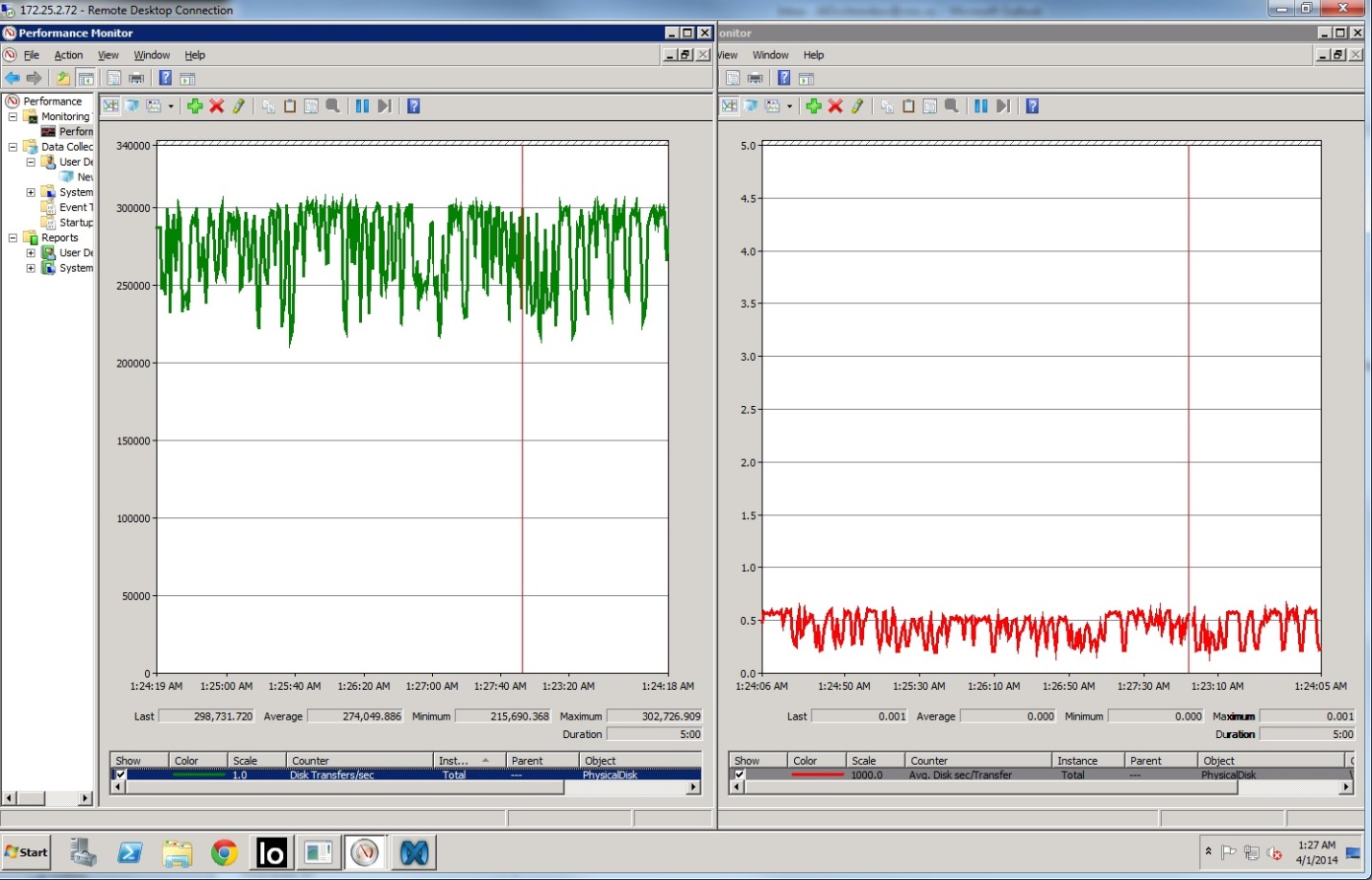

Record
With the record turned out as follows:
On sub-millisecond delays, we did not receive the declared characteristics, here we have achieved the limit:

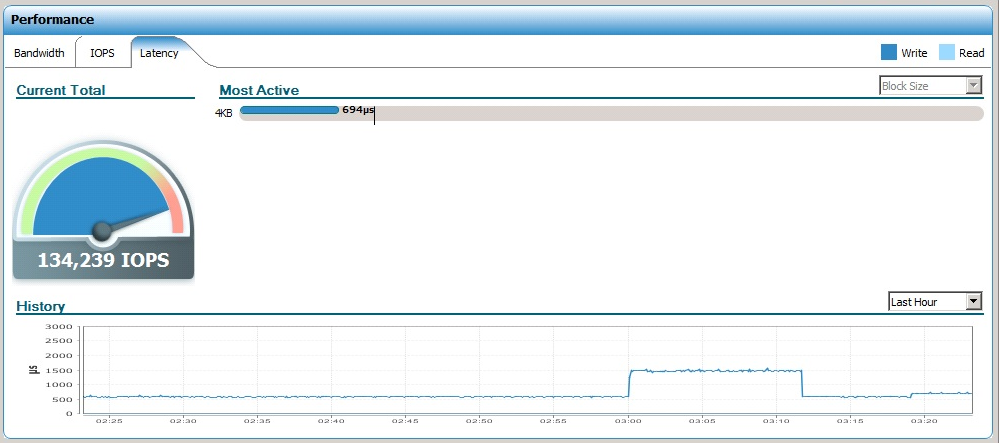
Nevertheless, to squeeze the maximum, if you do not look at the delay, it turned out quite easily:
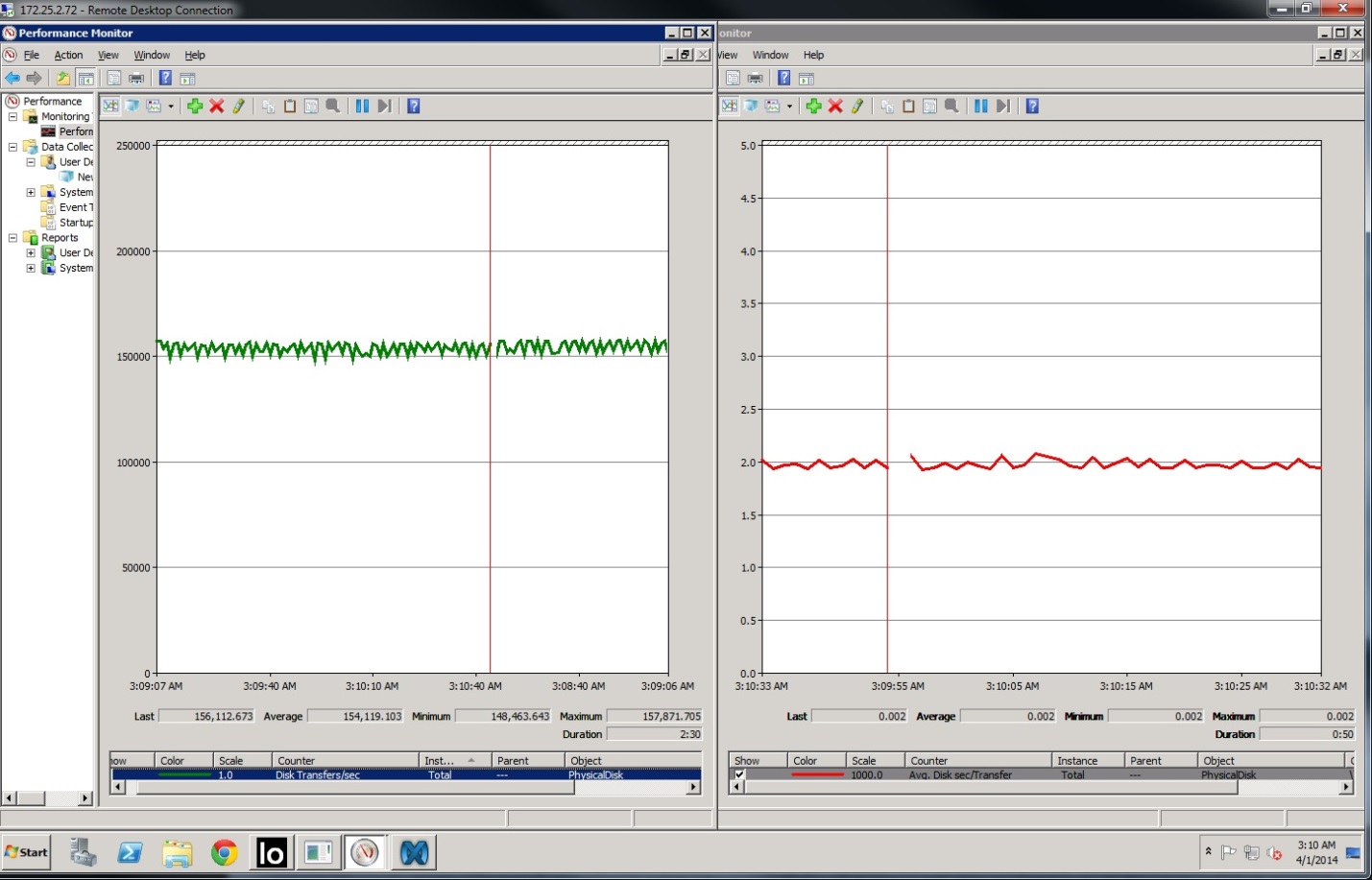
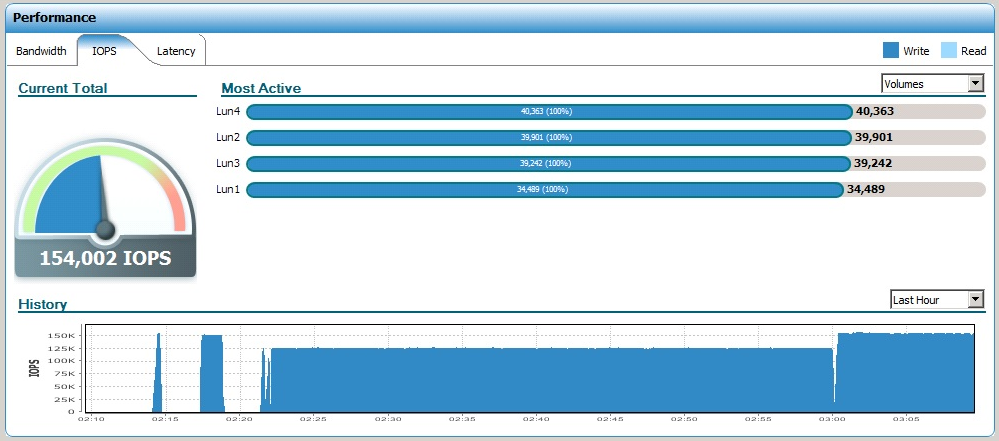
Only the delay on the array, of course, has grown above 1 ms.
Read / write
Here we lacked some 5 dozen IOPS to achieve the stated values:
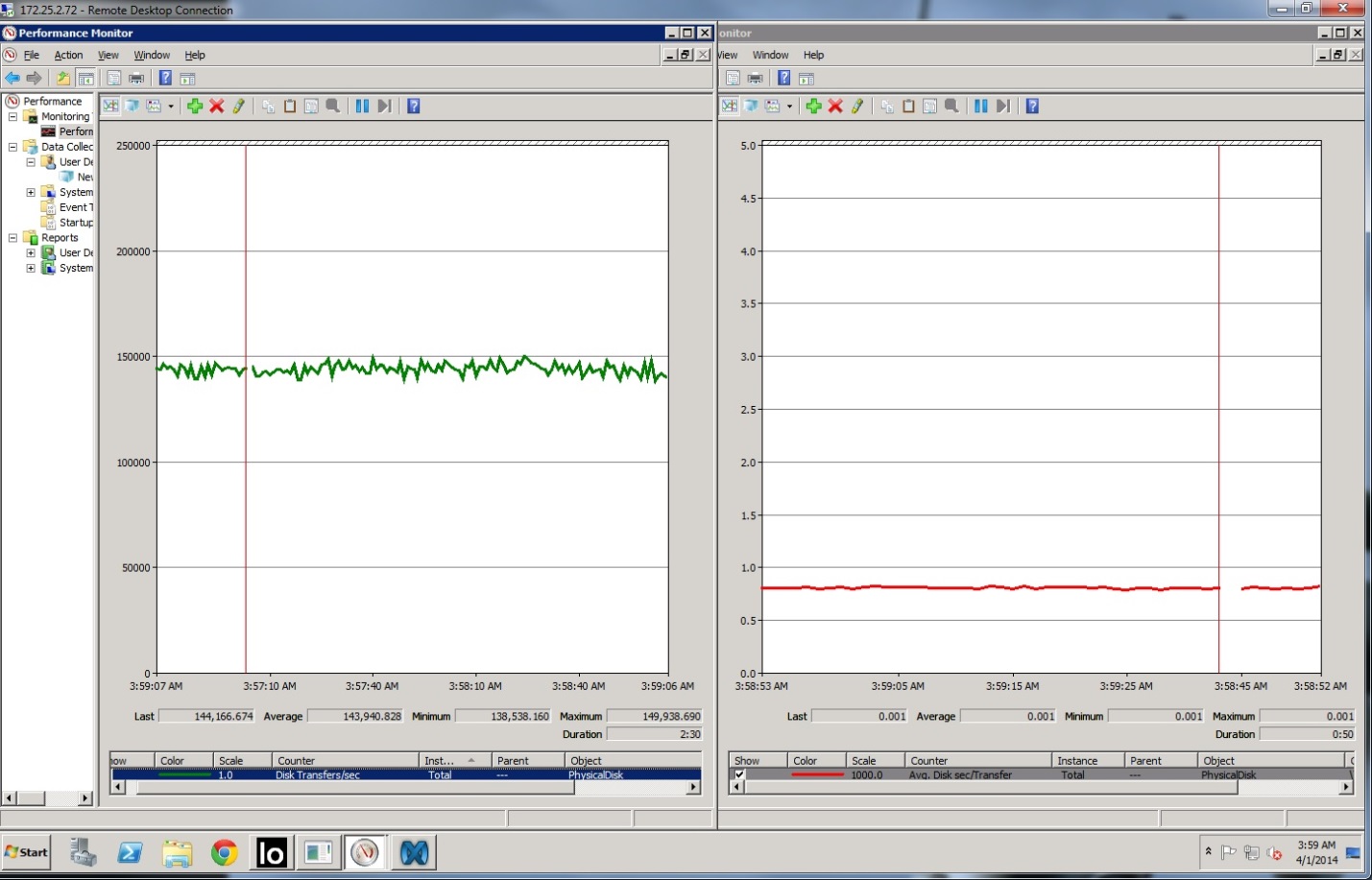
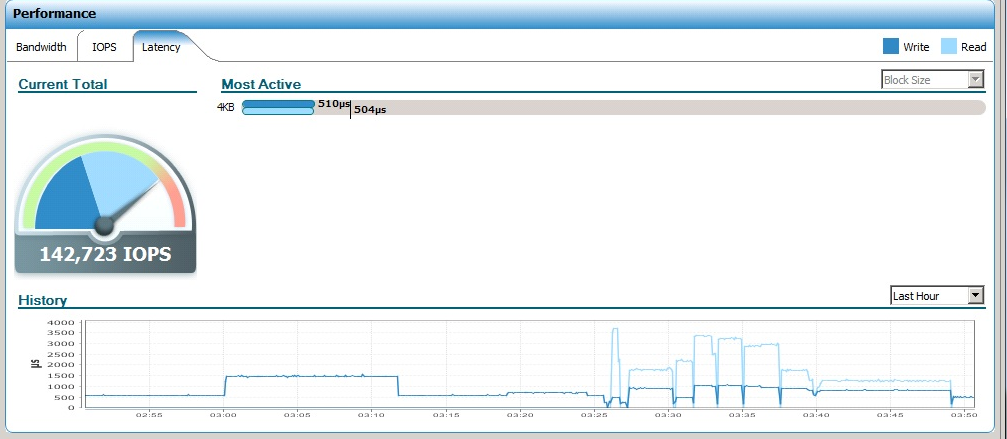
Of course, for the sake of interest, I tried to finish off these IOPS, but the delay inevitably crept up and went out in a millisecond, and, funnyly enough, the delay in reading was crawling:

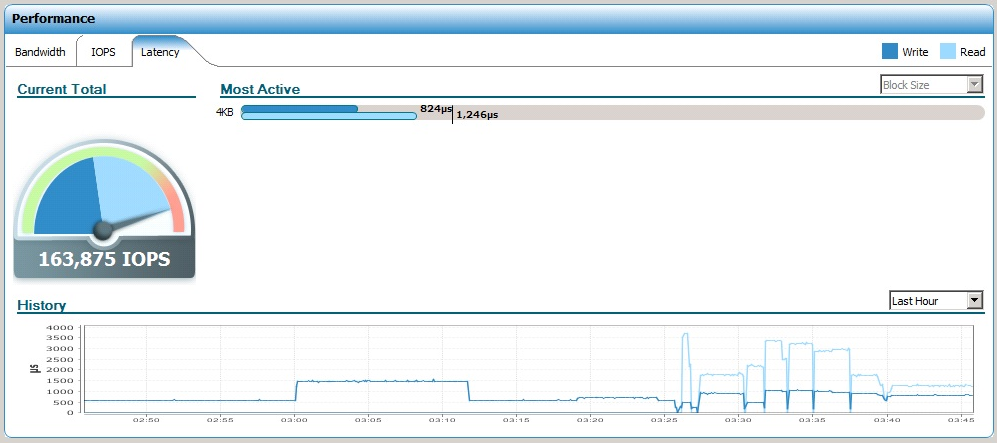
General sensations from the array
In general, from the point of view of the administrator, the system is very convenient and pleasant to manage, the setup is minimal and does not require serious configuration planning. In fact, the only thing that we should not forget is to connect the host to both controllers (this is often forgotten). At the same time, despite the small number of parameters, the interface is very informative and vivid, a more or less experienced administrator will have a couple of minutes to deal with everything.
From the point of view of a service engineer, the array is rather large in comparison with analogues. In my opinion, the sharpening of the array under VDI is very clearly seen, and the storage of “hot” data for the database of the financial, insurance, scientific and energy sectors, the ability to deduplicate data as strongly as possible is very critical.
From what else you liked - most of the components of the array are very convenient to change, with analogs usually more difficult.
In general, until recently, no one even thought about deduplication on the fly for flash storage, because of possible insertion delays. The EMC company not only thought, but also was able to present enterprise-level storage systems, where this technology became the key. This deduplication allows you to not write data to disk, if they already exist somewhere. That is, the write operation, in fact, is performed in the cache memory, providing an even better response time. Now EMC are the only ones doing inline deduplication inside the storage system. Others do this either as a separate piece of hardware or not on the fly, which, in particular, makes it possible to get rid of crutches in the form of RAM cache deduplication (it is simply not needed: the data gets there already processed). The new backup unit is immediately replaced by a link, wherever it is inside the system - what's in the cache, what's on the SSD. At the same time, the system does not try to store data in the cache, but immediately writes it to the SSD - this required the developer to revise the architecture, but it gave a performance gain. All this in a complex for VDI type solutions can reduce the number of records on the discs themselves to 30 or more times.
Price
Every time I show this or a similar box, a lot of questions arise about the price. I will answer the main ones. First, how much it costs: the price on the price is 28 million rubles, but in fact it always differs down (and significantly) due to the large number of programs and special conditions of the vendor. That is why prices for such solutions are usually not announced, but are indicated in the commercial offer for a specific implementation. If you work with high-loaded applications, then you completely understand that it is justified: it is a very fast storage system itself (it removes bottlenecks, for example, in banks, insurance and cellular operators), plus “sharpened” virtual environments. If you count on many practical highload solutions, the operation turns out to be much cheaper than a disk (the specifics are interesting - write, send the offer) And, finally, this storage system comes with support. In addition to software and consultations, the basic one implies the replacement of any nodes within 1 business day, and the extended one means leaving a maximum of 4 hours.
I invite to the test
The system with the photo above is now with us, and is used for tests and demos. If you want to test it for your tasks (in particular, according to your program) - write me at vbolotnov@croc.ru.
Source: https://habr.com/ru/post/220319/
All Articles